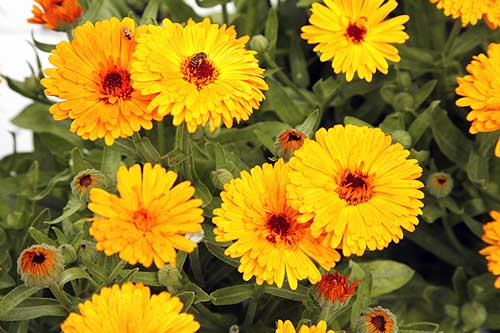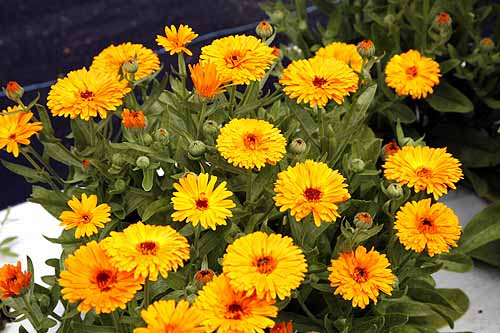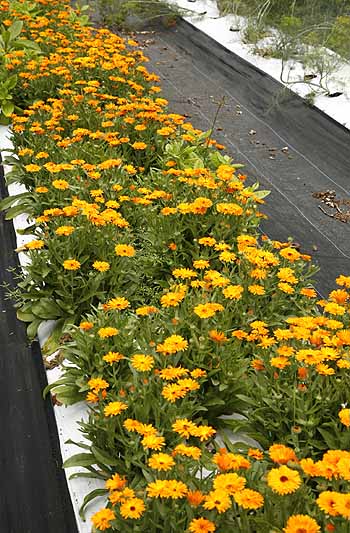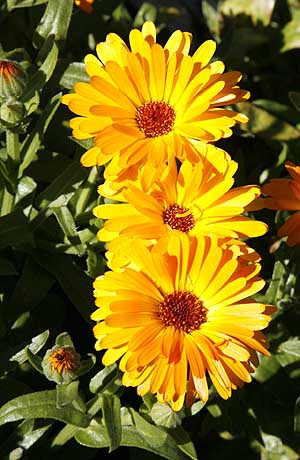Pot marigolds are beautiful hardy annuals that love full sunshine and a well drained by moist soil. In these conditions they will produce multitudes of golden daisy like flowers with an attractive scent. Extremely easy to grow and need little care, but deadheading will ensure a more continued show of flowers from late spring early summer until killing frost. In sunshine they are fairly compact and make wonderful border plants and mass plantings but are also ideal for window boxes and pots. The whole plant is aromatic and the flowers have a lovely scent. Butterflies and bees love the flowers, but deer and other wildlife really don't like to eat them. One of the most commonly used plants in home herbal medicine especially for bites, stings and skin complaints. A must for all gardeners.
Description of Pot Marigold (Calendula officinalis).
Pot marigold is the most ancient of the marigolds that we grow today and is
different in appearance and aroma. A hardy annual it has slightly succulent
stalk less lance shaped leaves that covered with fine rough hairs giving the
leaf a slightly rough feel. The mid green leaves first forms a small rosette
of leaves which are soon followed by stiff upright stems that also bear a multitude
of small stiff hairs. Leaves are arranged on the stems in slightly alternate
pairs with sections of bear stalk in between. Stems can be unbranched or branched
and are topped by bright yellow gold daisy like flowers with darker centers
and can be up to 4" in diameter. Petals are arranged in single rows are
oval in shape. Plants will form fairly compact groupings spreading to 8"
or less. Height will depend on sunlight high sun plants tend to be shorter than
those in semi shaded areas where they can reach 24" but be more lanky.
Flowers bloom from early spring until fall and are very sensitive to the weather.
The flowers will close at night only opening when the sun is higher in the sky,
they will also close on very cloudy days or when rain is expected. If flowers
are removed stems will branch more and produce more flowers, although if more
flowers are removed the size of the flowers will reduce in diameter. All parts
of the plant are highly aromatic and when cut exude a slightly sticky substance.
HOW TO GROW Pot Marigold (Calendula officinalis).
Location and Care
For best performing plants full sun on a well drained soil and reasonable water
is ideal. However some shade may be required in zones 8 or more as heat can
become too much especially at noon. If grown in partial shade in zones 6 or
lower plants will not be as compact, tending to have longer stems and less structure.
Not really fussy about soil type as long as its reasonable well drained can
tolerate pH from 5.3 - 6.8 or more. Does better with organic compost in the
soil.
For best results water every other day, using a soaker hose around the base
of the plants is ideal. Does not like to dry out entirely. Water during drought.
Great for borders, mass plantings and areas of the garden where you want
to make a big showing.
Removing flowers or dead heading (removing flowers after they have bloomed)
will increase the number of blooms that occur and encourage the plants to branch
out and produce more flowers although these will not be as large as the first
blooms if a large number of branches are formed. Remove flowers before they
go to seed or plant will stop flowering. If flowers are removed plant can be
encouraged to keep blooming until a hard frost kills it off.
It is recommended to wear light gloves when deadheading or cutting flowers as
the plants exude a sticky substance that can glue your fingers together. Its
also very aromatic.
For continual flowering plants can be seeded at regular intervals throughout
the year so have larger fresh blooms at all times.
Will do well with a little liquid fertilizer every week or once a month depending
on richness of the soil. Mulching around the plants with compost or leaf mulch
can help keep down weeds. Can also be grown in containers makes a wonderful
pot plant for the deck, patio or window box.
Growing Pot Marigold (Calendula officinalis) from Seed.
Extremely easy to grow. Best sown directly in place. Calendula seeds germinate
very quickly and grow rapidly the amount of time that is gained by starting
indoors then allowing them to establish outside is not really worthwhile unless
you are in zone 4a and above.
Prepare the soil well, remove all weeds and add some compost or well rotted
organic material. Place 2-3 seeds in each spot and space about 12" apart.
Water well until the seeds germinate which can be as little as 4 days in warm
conditions. Seeds can be sown in very early spring before last frost date if
desired as seeds are very hardy. This allows just as early a start as indoor
seeding.
For continuous large blooms seeds can be sown every 6-8 weeks and as new plants
begin to bloom older plants can be removed.
Companion planting.
Pot marigold can be planted around vegetables to help deter pests. It can help
repel aphids, snails, slugs and cabbage looper if planted close to susceptible
plants. Pot marigold (calendula) is not commonly bothered by pests itself although
in very humid conditions it may have some powdery mildew form. To help prevent
this ensure there is good airflow through the plant leaves.
Harvesting Pot Marigold (Calendula officinalis).
Flowers. Harvest on sunny days when the sun is high so that the flowers
are fully open. Snipe or pinch off the flower heads. When harvesting either
wear thin plastic gloves (vinyl, latex etc) or wash hands directly afterwards
due to the sticky resin that the plants exude. Harvesting flowers will encourage
more to form although these will be slightly smaller and the plant is encouraged
to branch. Plants will be stimulated to produce flowers up until the killing
frost if harvesting is continued. If flowers are left to seed plants will stop
flowering and may die.
Dry flower heads quickly out of the sun to prevent bleaching. Ensure they are fully dry before storing as mold can be a problem is not dried fully. If cannot dry immediately flowers can be stored in plastic bags in the refrigerator for several days before drying.
Leaves. Harvest younger leaves when the dew has evaporated and they are dry. Cut or pinch them from the plant taking only about 35% from each plant to ensure it has sufficient to promote more growth. Using light disposable gloves is recommended due to the sticky nature of the sap produced. Dry leaves rapidly to prevent mold. If cannot dry immediately they can be stored in plastic bags in the refrigerator for a few days first.
Edible Uses of Pot Marigold (Calendula officinalis).
Leaves can be eaten in salads or added to soups, stir fry and other dishes.
They have a viscid sweetness, followed by a strong penetrating taste of a saline
nature, some people like it some don't. They are rich in vitamins and minerals
and are similar to Taraxacum officinale (Dandelion) in nutritional value.
The flowers can also be eaten in the same way or dried flowers can be used in
tea. An edible yellow dye can be made from the petals and used as a saffron
substitute to color rice dishes as well as potatoes, soups and desserts.
Medical uses of Pot Marigold (Calendula officinalis).
Pot marigold (calendula) is one of the most widely know, popular and commonly
used herbs in home use today. It is extremely versatile but its most common
use is as
a cream or lotion for treating skin problems especially bites and
stings, sprains, wounds and varicose veins. Soaked into a cloth it is used to
treat sore eyes. Internally it is used in treating chronic infections and fevers
and chronic ulcers. In some areas a decoction is used to help draw out smallpox
and measles. .
Caution.
Some people find they are irritated by the sticky compounds that the plant exudes.
In these people it can cause allergic skin reactions. Those who have sensitivities
to other members of the daisy family need to be cautious. In suspect cases start
with a low dose or concentration. Always wear gloves when handling plants.
Ensure that if growing for medical use that you are growing pot marigold C.
officinalis, not other species of marigolds (Tagetes spp.) as these do not have
the same medicinal properties.
Other uses
A yellow dye has also been extracted from the flower, by boiling. Also makes
a very attractive cut flower with pleasant scent. An essential oil is extracted
from the plant and used in perfumes.
Other names.
Pot Marigold, Common Marigold, Scotch Marigold, Ruddles, Pot Marigold
Synonyms
Calendula aurantiaca. Calendula eriocarpa. Calendula hydruntina. Caltha officinalis.









